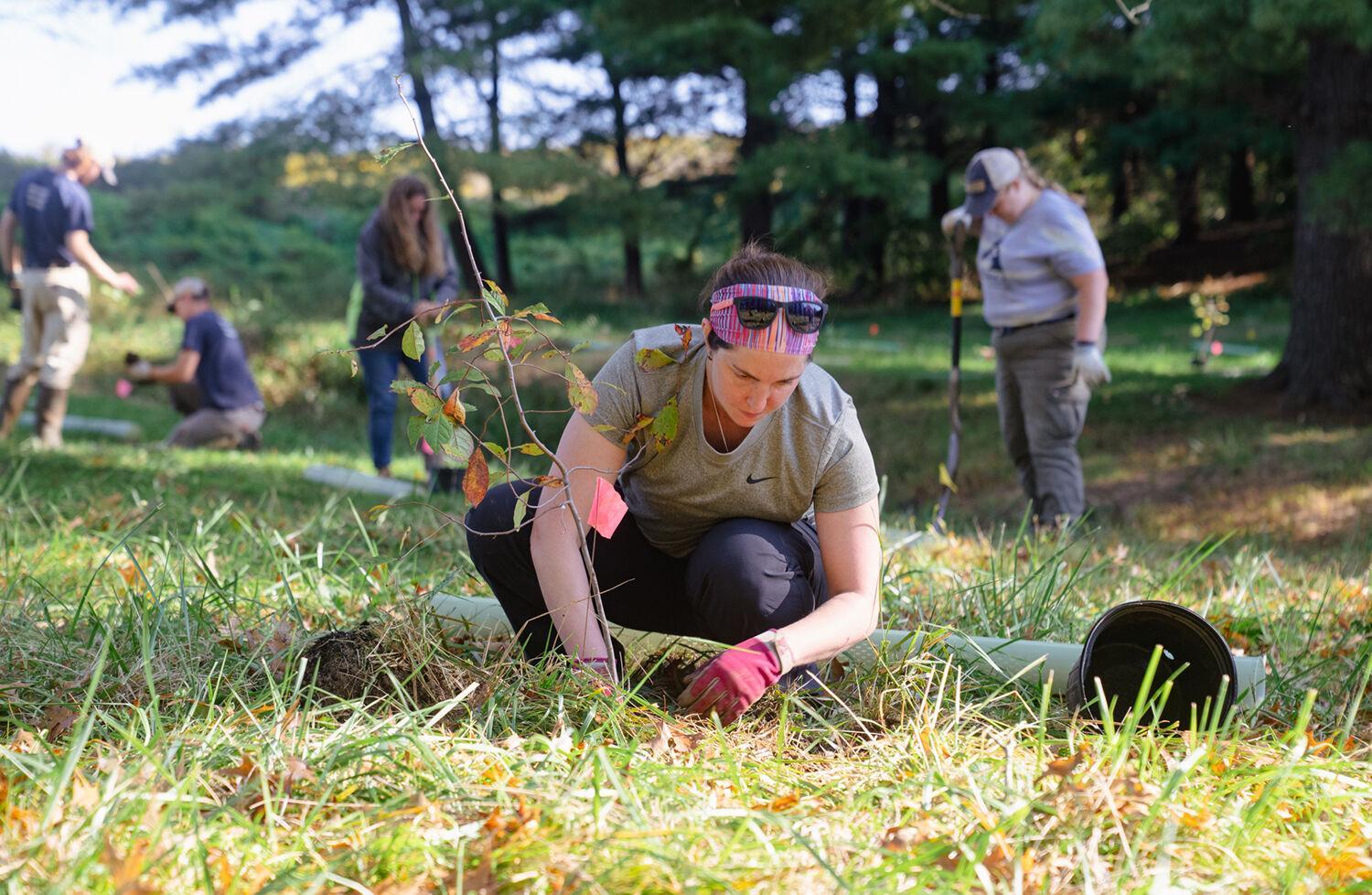Craig Highfield, Forest Programs Director, Alliance for the Chesapeake Bay

A volunteer works with the Alliance for the Chesapeake Bay to plant a streamside buffer in Lancaster County, PA. Photo by Eric Braker/Alliance for the Chesapeake Bay
Spring is here, and there is no better time to get outside and plant new trees on your property or in your community.
And opportunities to do so abound this time of year. The Alliance for the Chesapeake Bay and many other environmental groups are hosting tree-planting events throughout the region to improve water quality, create wildlife habitat, clean the air and enhance climate resiliency for the watershed.
Our forests have always endured natural stresses and disturbances like fires, storms, drought, insects and pathogens — not to mention human-caused disturbances like deforestation, fragmentation and invasive species. The impacts of climate change in the Bay region will certainly exacerbate these stresses and alter the composition of our forests in various ways.
Unlike the western U.S., where periods of drought are expected to increase and be more severe because of climate change, the East will likely see an increase in annual rainfall. The pattern of precipitation is also predicted to change. Our region will likely see an increase in precipitation in the winter and spring and longer periods of drought in the summer and fall. We will also see more frequent and intense storms.
Climate change is already lengthening our growing season and shortening our winters. The eastern U.S. just experienced one of its warmest winters in our history.
Several forest tree species will respond positively to a longer growing season and the increase in carbon dioxide. But these conditions can also be quite advantageous for the proliferation of invasive nonnative plants, especially those that already break bud earlier and go dormant later than our native deciduous vegetation.
Many forest insect pest populations will expand because they are no longer subject to natural control by long, deleterious periods of below-freezing temperatures.
The species composition of our forests has consistently changed over the millennium and will likely continue to do so because of new climate conditions. According to an exhaustive report from the U.S. Forest Service, species that will likely tolerate periodic dry spells and warmer summers include black oak, northern red oak, pignut hickory, sweetgum, white oak and yellow pine. Species that thrive in moist soil conditions, like white pine, sugar maple, American beech, eastern hemlock and red spruce, will likely be diminished.
Mid-Atlantic forest types that have been shaped by disturbance over the millennia — like oak-hickory or oak-pine communities — will likely not change dramatically. But some of the region’s rarer forest types — spruce-fir in the high elevations of the Appalachian Mountains and lowland conifer forests — may be the most vulnerable to higher temperatures and varying soil moisture in the summer and fall.
Maritime and tidal swamp forest ecosystems in the coastal plain region are also expected to suffer from the effects of sea level rise, storm surges and saltwater intrusion.
Finding a tree-planting event to join is as easy as typing “volunteer tree planning near me” in your search engine.
If you own a patch of forest or mostly wooded land, the bar is a little higher. I suggest contacting your state’s native plant society (every state in the Bay watershed has at least one) for advice on native species that are best suited for your land — and, if it’s a well-established forest, how you can best manage it.
Controlling invasive plants helps existing trees grow and sequester carbon while allowing new trees to regenerate. Thinning a crowded stand of trees reduces the stress of competition and allows the remaining trees to vigorously grow in response to the additional light. It also helps trees defend themselves against threats from insects and pathogens.
Promoting a diversity of species in your woods helps to buffer it from a variable climate and soil moisture regimes. Periodic selective harvesting can also be beneficial, as long as soil disturbance is kept to a minimum and the remaining trees are protected — to continue carbon storage and sequestration while new trees emerge.
The American Forest Foundation and Nature Conservancy have developed their Family Forest Carbon Program to help private woodland owners turn enhanced carbon-sequestration practices into income through voluntary carbon markets.
Both Maryland and Pennsylvania have set reforestation goals with the 5 Million Tree Initiative and the Keystone 10 million Trees Partnership, respectively. Successful reforestation requires planting the most suitable tree species for the specific and future site conditions of the parcel and providing care for the new forest until it is established.
There are several nongovernmental organization and public conservation programs available to support reforestation endeavors, including several with the Alliance for the Chesapeake Bay.
There is little doubt that our woodlands provide a multitude of public benefits like clean water and air, wildlife habitat, flood mitigation, forest products, recreational opportunities and more. So it should be of little surprise that healthy thriving woodlands are one of our best tools to buffer us against the deleterious impacts of climate change. We just need to help them help us.
Branching Out, Vol. 31, no. 2 (Spring 2023)
Branching Out is the free, quarterly newsletter of the Woodland Stewardship Education program. For more than 30 years, Branching Out has kept Maryland woodland owners and managers informed about ways to develop and enhance their natural areas, how to identify and control invasive plants and insects, and about news and regional online and in-person events.